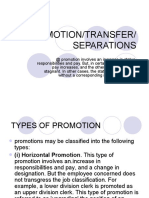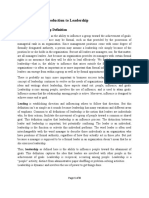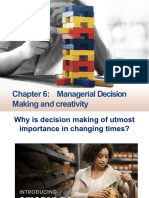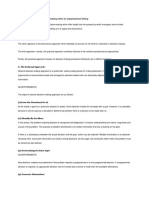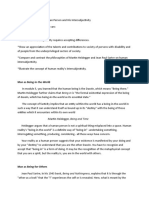0 ratings0% found this document useful (0 votes)
1K viewsDecisions
Decisions
Uploaded by
krithideepThe document outlines four approaches to decision making: rational, behavioural, practical, and personal. The rational approach uses logical steps but assumes perfect information. The behavioural approach accounts for limited rationality. The practical approach combines rational and behavioural approaches. The personal approach focuses on how individuals make difficult decisions dealing with emotions.
Copyright:
© All Rights Reserved
Available Formats
Download as PPT, PDF, TXT or read online from Scribd
Decisions
Decisions
Uploaded by
krithideep0 ratings0% found this document useful (0 votes)
1K views15 pagesThe document outlines four approaches to decision making: rational, behavioural, practical, and personal. The rational approach uses logical steps but assumes perfect information. The behavioural approach accounts for limited rationality. The practical approach combines rational and behavioural approaches. The personal approach focuses on how individuals make difficult decisions dealing with emotions.
Original Title
decisions.ppt
Copyright
© © All Rights Reserved
Available Formats
PPT, PDF, TXT or read online from Scribd
Share this document
Did you find this document useful?
Is this content inappropriate?
The document outlines four approaches to decision making: rational, behavioural, practical, and personal. The rational approach uses logical steps but assumes perfect information. The behavioural approach accounts for limited rationality. The practical approach combines rational and behavioural approaches. The personal approach focuses on how individuals make difficult decisions dealing with emotions.
Copyright:
© All Rights Reserved
Available Formats
Download as PPT, PDF, TXT or read online from Scribd
Download as ppt, pdf, or txt
0 ratings0% found this document useful (0 votes)
1K views15 pagesDecisions
Decisions
Uploaded by
krithideepThe document outlines four approaches to decision making: rational, behavioural, practical, and personal. The rational approach uses logical steps but assumes perfect information. The behavioural approach accounts for limited rationality. The practical approach combines rational and behavioural approaches. The personal approach focuses on how individuals make difficult decisions dealing with emotions.
Copyright:
© All Rights Reserved
Available Formats
Download as PPT, PDF, TXT or read online from Scribd
Download as ppt, pdf, or txt
You are on page 1of 15
Approaches to Decision Making
The following are the four types of Approaches to
Decision Making:
• Rational - This approach is appealing as it is
logical and economical.
• Behavioural - This approach attempts to account
for the limits on rationality in decision-making.
• Practical - This approach combines features of the
rational and behavioural approaches.
• Personal – This approach focuses on decision-
making processes individuals use in difficult
situations.
Rational Decision Making Approach
Rational decision-making approach is a
systematic, step-by-step process for making
decisions.
It assumes that the organization is
economically based and managed by
decision-makers who are absolutely
objective and have complete information.
Steps in Rational Decision
Making Approach
The following are the steps in rational decision-making:
• (1) State the Situational Goal,
• (2) Identify the Problem,
• (3) Determine Decision Type,
• (4) Generate Alternatives,
• (5) Evaluate Alternatives,
• (6) Choose an Alternative,
• (7) Implement the Plan and
• (8) Control.
Steps in Rational Decision Making
Approach (Contd.)
(1) State the Situational Goal
• A goal is stated for a particular situation.
• It can be used as a standard in determining the decision to
be made later on.
(2) Identify the Problem:
• The problem requiring decision is recognized and
diagnosed.
• It involves understanding the nature, magnitude and causes
of the problem.
• The purpose of problem identification is to collect
information that has a bearing on the goal.
• If there is a discrepancy between the actual situation and the
goal, action may be required.
• The constraints within which the problem must be solved
are also defined.
Steps in Rational Decision
Making Approach (Contd.)
(3) Determining Decision Type:
• Now decision- makers must determine if the problem
requires a programmed or a non-programmed decision.
• If a programmed decision is required, an appropriate
decision rule is invoked and a choice is made from the
available alternatives.
(4) Generate Alternatives:
Alternatives are generated by decision maker on the basis
of the academic & professional education, experience and
knowledge about the situation.
Information may be sought from colleagues, subordinates,
experts and superiors.
Decision-makers may analyze the symptoms of the
problems for clues or rely on their own intuition or
judgement to generate alternative solutions.
Steps in Rational Decision
Making Approach (Contd.)
(5) Evaluate Alternatives:
• Each alternative is assessed based on its Strengths &
weaknesses, costs & benefits, as well as, possible negative
consequences keeping in mind predetermined decision
criteria.
• The positive consequences must be weighed against
negative consequences.
• The ultimate decision criterion is whether a particular
decision will bring the decision maker nearer to goal.
• The evaluation process usually includes:
(a) Describing the anticipated outcomes of each
alternative,
(b) Evaluating the anticipated costs of each alternative, and
(c) Estimating the uncertainties and risks associated with
each alternative.
Steps in Rational Decision Making
Approach (Contd.)
(6) Choose an Alternative:
• It involves selecting the best alternative with maximum
positive consequences, least or no negative outcomes, less
risks and minimum costs.
• The expected value of each alternative is determined and
the alternative with the largest expected values is selected.
• It is important to consider contingency plans.
• Contingency plans are alternative actions to take if the
primary course of action is unexpectedly disrupted or
rendered inappropriate.
• Planning for contingencies is part of the transition between
choosing the preferred alternative and implementing it.
Steps in Rational Decision Making
Approach (Contd.)
(7) Implementing the Plan:
• Once a decision is formally accepted, an authorisation is
made for its implementation.
• Implementation puts the decision into action and involves
communicating the decision, gathering support for and
acquiring and assigning resources to ensure that it is
carried out.
• It builds on the commitment and motivation of those
involved in the decision-making process.
• Successful implementation requires appropriate use of
resources and good management skills, leadership
characteristics, reward structure & knowledge and
application of group dynamics.
Steps in Rational Decision Making
Approach (Contd.)
(8) Control:
• This is the final stage of rational decision-making
process, wherein, the outcomes of the decision are
measured and compared with the predetermined,
desired goals.
• If there is a discrepancy between the two, the decision-
maker may restart the process of decision-making by
revising/modifying/setting new goals.
Strengths and Weaknesses of the
Rational Approach
This approach has several strengths.
It forces the decision-maker to consider a decision in a
logical, sequential manner and an in-depth analysis of
alternatives helps him to choose on the basis of
information rather than personal prejudices, emotions or
social pressure.
Its weaknesses are that the manager does not always have
perfect information, faces time and financial constraints,
may have limited ability to process information and may
not be able to predict future accurately.
Also, all the alternatives cannot be quantified making
comparisons difficult.
Behavioural Approach
This approach assumes that decision-makers operate with
bounded rationality rather than with the perfect rationality
assumed by the rational approach.
Bounded rationality is the idea that decision makers cannot
deal with information about all the aspects and alternatives
pertaining to a problem and therefore choose to tackle
some meaningful subset of it.
This process is neither exhaustive nor completely rational
and therefore, solutions arrived at are not entirely ideal.
Decision-makers operating with bounded rationality limit
the inputs to the decision-making process, focus their
attention on two or three most favourable alternatives,
process these in great detail and base their decisions on
judgement and personal biases as well as logic.
Features in Behavioural Approach
This approach possesses the following features:
• (i) Use of procedures and rules of thumb which reduce
uncertainty in decision-making initially.
• (ii) Sub optimizing which refers to knowingly accepting
less than the best possible outcome to avoid unintended
negative effects on other aspects of the organization.
• (iii) “Satisfying refers to examining alternatives only until a
solution that meets minimal requirements is found and
then making no further efforts to look for a better one.
• The search for alternatives is generally a sequential process
based on procedures and rules of thumb guided by
previous experiences with similar problems.
• Such a solution may not always be the optimal solution
since the search often ends when the first minimally
acceptable alternative is identified.
Practical Approach
This approach combines the steps of the rational
approach with the features and conditions of the
behavioural approach to create a more realistic process
for making decisions.
The decision-maker try to go beyond rules of thumb
satisfying limitations, generate as many alternatives as
possible within the given time, money and other
practicalities of the situation.
Managers who have tendency to jump from one
decision to another, making decisions hastily and
impulsively usually do not use much information.
Personal Approach
Personal Approach helps in decision making when
decision makers are nervous, anxious, worried or
agitated.
Personal approach deals with the personal conflicts
that people experience in particularly difficult decision
situations.
Basic Characteristics of Personal Approach
The Personal Approach has five basic characteristics:
(a) It deals with important life decisions, such as, choosing
the nature and type of education & institution, career,
marriage and major organizational decisions.
(b) It recognizes that procrastination and rationalization
are mechanisms by which people avoid taking difficult
decisions and coping with the accompanying stress.
(c) It explicitly acknowledges that some decisions could
possibly go wrong.
(d) It provides for self-reactions in terms of comparisons of
alternatives with internalized moral standards.
(e) It recognizes that at times the decision-maker is
uncertain about alternative courses of action.
This kind of situation makes it difficult for him to give a
whole-hearted commitment to one single decision.
You might also like
- Bernard Williams - Morality. An Introduction To Ethics Cambridge, 1972)Document59 pagesBernard Williams - Morality. An Introduction To Ethics Cambridge, 1972)Aleksandra Pawlik100% (12)
- Chapter 1 Importance of PersonalityDocument29 pagesChapter 1 Importance of PersonalityRAMIREZ, KRISHA R.100% (1)
- Concept, Nature, Scope and Functions of ManagementDocument8 pagesConcept, Nature, Scope and Functions of Managementrohan_jangid889% (18)
- Ethical Decision Making PowerpointDocument28 pagesEthical Decision Making PowerpointSilfi ShintaNo ratings yet
- Test Bank: Human Resource Management, 9 EditionDocument18 pagesTest Bank: Human Resource Management, 9 EditionThuận PhạmNo ratings yet
- Chapter 1 - Principles of ManagementDocument26 pagesChapter 1 - Principles of ManagementLisa Galina100% (1)
- Barriers To Horizontal CommunicationDocument8 pagesBarriers To Horizontal CommunicationMd. Ariful Haque100% (1)
- Human Resource Management: Recruitment and SelectionDocument26 pagesHuman Resource Management: Recruitment and SelectionFatima Mae Dela CruzNo ratings yet
- The Power SchoolDocument17 pagesThe Power SchoolWaqar Afzaal100% (1)
- EQ in Action WorkshopDocument26 pagesEQ in Action Workshopstudent1291100% (1)
- Killeen1998. Soledad Como Epidemia de La Sociedad ModernaDocument9 pagesKilleen1998. Soledad Como Epidemia de La Sociedad Modernacheby92No ratings yet
- Learning ObjectivesDocument12 pagesLearning Objectivess11032944100% (2)
- Communication and Decision MakingDocument53 pagesCommunication and Decision MakingBehar AbdurahemanNo ratings yet
- Impression Management TechniqueDocument17 pagesImpression Management TechniqueFOuadHasan100% (2)
- Chapter 5 Conflict Management 1Document31 pagesChapter 5 Conflict Management 1Tina Ganvir100% (2)
- 1.0 The Introduction To Customer ServiceDocument45 pages1.0 The Introduction To Customer Serviceallya100% (1)
- Ethics and Ethical ReasoningDocument32 pagesEthics and Ethical ReasoningyagesNo ratings yet
- Characteristics of A Good VisionDocument2 pagesCharacteristics of A Good VisionwubeNo ratings yet
- Maslow' S Hierarchy Abraham MaslowDocument38 pagesMaslow' S Hierarchy Abraham MaslowCriza Mae Castor PadernalNo ratings yet
- Chapter 3 Quiz KeyDocument6 pagesChapter 3 Quiz Keyv9pratapNo ratings yet
- Organizational Leadership: Topic: University of Michigan & Ohio StudiesDocument9 pagesOrganizational Leadership: Topic: University of Michigan & Ohio StudiesprathibakbNo ratings yet
- Organization and ManagementDocument5 pagesOrganization and ManagementKathlene JaoNo ratings yet
- Chapter 3 (PERFORMANCE MANAGEMENT AND STRATEGIC PLANNING)Document18 pagesChapter 3 (PERFORMANCE MANAGEMENT AND STRATEGIC PLANNING)shakeelakousar24100% (3)
- Sources of Data: Research MethodologyDocument13 pagesSources of Data: Research MethodologySakshi SharmaNo ratings yet
- Unit 13 Strategy Formulation and Strategic ChoiceDocument9 pagesUnit 13 Strategy Formulation and Strategic ChoicePradip HamalNo ratings yet
- Group DynamicsDocument5 pagesGroup DynamicsJiten DasNo ratings yet
- The Role of HR Management in The Management ProcessDocument5 pagesThe Role of HR Management in The Management ProcessAtif IqbalNo ratings yet
- CH 09 Influence of Culture On CBDocument12 pagesCH 09 Influence of Culture On CBBujorianu SimonaNo ratings yet
- Leadership and Decision Making PDFDocument34 pagesLeadership and Decision Making PDFNhi PhamNo ratings yet
- Chapter 5 OrganizingDocument28 pagesChapter 5 OrganizingDagm alemayehuNo ratings yet
- Module 3 Ethics in Communication 1Document13 pagesModule 3 Ethics in Communication 1Raffy Alovera ArceoNo ratings yet
- Unit 4Document13 pagesUnit 4Elaiya BharathiNo ratings yet
- 7 Personal Influence and Diffusion of InnovationsDocument37 pages7 Personal Influence and Diffusion of InnovationsReasat AzimNo ratings yet
- Barriers To Critical ThinkingDocument10 pagesBarriers To Critical ThinkingJohn DoeNo ratings yet
- Training Evaluation - PPT 6Document29 pagesTraining Evaluation - PPT 6ERMIYAS TARIKUNo ratings yet
- Types of Need Assessment and DefinitionDocument4 pagesTypes of Need Assessment and DefinitionAugusta AltobarNo ratings yet
- Chapter 1 - Introduction To Business EthicsDocument15 pagesChapter 1 - Introduction To Business EthicsNurhidayah Binti KhairudinNo ratings yet
- Unit-1 Question BankDocument2 pagesUnit-1 Question BankKruti Bhatt100% (1)
- Factors Influencing AttitudeDocument3 pagesFactors Influencing AttitudeJoshua PasionNo ratings yet
- Autocratic LeadershipDocument2 pagesAutocratic LeadershipJohn Anthony B. LimNo ratings yet
- HRM Course Pack 2023Document121 pagesHRM Course Pack 2023lakshaypopli9No ratings yet
- Interapersonal & InterpersonalDocument14 pagesInterapersonal & InterpersonalRimshaNo ratings yet
- MANAGEMENT AS A GROUP PDocument18 pagesMANAGEMENT AS A GROUP PopulitheNo ratings yet
- Dimensions of Interpersonal RelationshipsDocument10 pagesDimensions of Interpersonal Relationshipsasif razaNo ratings yet
- Answer The Following Questions Correctly!Document34 pagesAnswer The Following Questions Correctly!Julhan GubatNo ratings yet
- Leadership and Change Management MustDocument33 pagesLeadership and Change Management MustDECHASA GELETA100% (3)
- Research Methods: 03/13/21 1 Ali Yassin Sheikh, PHDDocument13 pagesResearch Methods: 03/13/21 1 Ali Yassin Sheikh, PHDEng-Abdirahman Haji Mohamed NurNo ratings yet
- Group 3 - Evaluating Selection Techniques and DecisionsDocument40 pagesGroup 3 - Evaluating Selection Techniques and Decisionsirishkate matugasNo ratings yet
- Issues For Review and DiscussionDocument11 pagesIssues For Review and DiscussionMuhammad Haseeb KhalidNo ratings yet
- Behavior in Formal and Informal GroupsDocument4 pagesBehavior in Formal and Informal Groupsjennifer pagatpatan100% (1)
- OB MBS Unit 2 Foundations of Individual BehaviourDocument17 pagesOB MBS Unit 2 Foundations of Individual BehaviourNabin SijaliNo ratings yet
- Promotion Transfer SeparationsDocument22 pagesPromotion Transfer SeparationssambitacharyaNo ratings yet
- 02-Product DecisionDocument38 pages02-Product DecisionJyoti Yadav100% (1)
- Quality Management, Ethics, and Corporate Social ResponsibilityDocument14 pagesQuality Management, Ethics, and Corporate Social ResponsibilityAllain GuanlaoNo ratings yet
- Chapter 1Document8 pagesChapter 1Ebsa AdemeNo ratings yet
- New Trends Shaping HRMDocument20 pagesNew Trends Shaping HRMSs ArNo ratings yet
- Chapter 1 Introduction To EntrepreneurshipDocument34 pagesChapter 1 Introduction To Entrepreneurshipsamuel lireNo ratings yet
- Define and Measure PersonalityDocument2 pagesDefine and Measure PersonalityMuhammad Hashim MemonNo ratings yet
- Resourse AllocationDocument10 pagesResourse Allocationindra singhNo ratings yet
- Business Customs in Global MarketingDocument4 pagesBusiness Customs in Global MarketingKrishnan Srinivasan0% (1)
- Nature of Business ResearchDocument5 pagesNature of Business Researchcyka blyat100% (1)
- CH 6 Managerial Decision Making and CreativityDocument58 pagesCH 6 Managerial Decision Making and Creativityserenespiritwellness100% (1)
- 4 Types of Approach To Decision 3.4 Dipti.kDocument5 pages4 Types of Approach To Decision 3.4 Dipti.kDiptimayee KandiNo ratings yet
- Mobile CommerceDocument28 pagesMobile CommercekrithideepNo ratings yet
- SelectionDocument25 pagesSelectionkrithideepNo ratings yet
- CellularDocument66 pagesCellularkrithideepNo ratings yet
- Lecture - Chapter 8 - Population Ecology-DemographyDocument30 pagesLecture - Chapter 8 - Population Ecology-DemographykrithideepNo ratings yet
- Emarketing: By: Iman Marafie, Nora Zehery Mohammed Buhamad Abdulaziz Mohammed Fahad Al AmeerDocument15 pagesEmarketing: By: Iman Marafie, Nora Zehery Mohammed Buhamad Abdulaziz Mohammed Fahad Al AmeerkrithideepNo ratings yet
- Cellular Wireless NetworksDocument70 pagesCellular Wireless NetworkskrithideepNo ratings yet
- COMP7880: E-Business Strategies: Mobile CommerceDocument49 pagesCOMP7880: E-Business Strategies: Mobile CommercekrithideepNo ratings yet
- The Consumer Protection Act, 1986Document73 pagesThe Consumer Protection Act, 1986krithideepNo ratings yet
- Cellular Wireless NetworksDocument70 pagesCellular Wireless NetworkskrithideepNo ratings yet
- Social MediaDocument1 pageSocial MediakrithideepNo ratings yet
- M.Bhavani 24-05-2010Document1 pageM.Bhavani 24-05-2010krithideepNo ratings yet
- Bio FertilizerDocument35 pagesBio FertilizerkrithideepNo ratings yet
- Finance: Finance Is A Field That Deals With The Allocation ofDocument3 pagesFinance: Finance Is A Field That Deals With The Allocation ofkrithideepNo ratings yet
- Unit I Tqm-History and Evolution: Awards and Guidelines - ISO, MBNQA, EFQMDocument28 pagesUnit I Tqm-History and Evolution: Awards and Guidelines - ISO, MBNQA, EFQMkrithideepNo ratings yet
- Ib Iii UnitDocument31 pagesIb Iii UnitkrithideepNo ratings yet
- Case Study 1 ObDocument3 pagesCase Study 1 Obsyahida shaffieNo ratings yet
- Module 9Document8 pagesModule 9Guin leeNo ratings yet
- A Psycho Social System Approach To Well Being Empirically Deriving The Five Domains of Positive FunctioningDocument13 pagesA Psycho Social System Approach To Well Being Empirically Deriving The Five Domains of Positive Functioningloren morelliniNo ratings yet
- Is Money The Best Motivator Four Drive T PDFDocument6 pagesIs Money The Best Motivator Four Drive T PDFSemra RaheelNo ratings yet
- Self Awareness WorksheetDocument9 pagesSelf Awareness Worksheetjefferson100% (2)
- The Study of The Undivided Personality PDFDocument10 pagesThe Study of The Undivided Personality PDFCC TANo ratings yet
- Encouragement 101 Per DevDocument14 pagesEncouragement 101 Per DevKaye Ortega Navales Tañales67% (3)
- Positive Nihilism My Confrontation With Heidegger Annas Archive Libgenrs NF 3319174Document95 pagesPositive Nihilism My Confrontation With Heidegger Annas Archive Libgenrs NF 3319174ChrisvrousNo ratings yet
- Gen Ed. 8: Ethics: Cor Jesu College, Inc. College of Education, Arts and SciencesDocument5 pagesGen Ed. 8: Ethics: Cor Jesu College, Inc. College of Education, Arts and Sciencesnove lolette cordovezNo ratings yet
- A Kierkegaardian Evaluation of The AesthDocument11 pagesA Kierkegaardian Evaluation of The AesthurskaNo ratings yet
- Resilience Series - Keeping Things in Perspective - EnglishDocument22 pagesResilience Series - Keeping Things in Perspective - EnglishToother MartinezNo ratings yet
- Phi 401Document10 pagesPhi 401Rashmita AcharyaNo ratings yet
- A - Process - Model - of - Integral - Theory Bonnita RayDocument50 pagesA - Process - Model - of - Integral - Theory Bonnita RayAntonio P100% (1)
- Group 4Document7 pagesGroup 4Jay JayNo ratings yet
- This Study Resource Was: Department of EducationDocument4 pagesThis Study Resource Was: Department of EducationAshlee Ayelle Koh Landicho100% (2)
- The Investigation of Main Cause of Off-Task Behavior in The ClassroomDocument14 pagesThe Investigation of Main Cause of Off-Task Behavior in The ClassroomMuh. Mahrup Zainuddin Sabri SuhamdiNo ratings yet
- Freedom FlightDocument1 pageFreedom Flightdocwavy9481No ratings yet
- OB CaseStudy 1Document4 pagesOB CaseStudy 1Navneesh TyagiNo ratings yet
- Day 1 - All Relationship Is ConnectionDocument9 pagesDay 1 - All Relationship Is ConnectionNaoe D'Artiste PixNo ratings yet
- Page 315 # 1, 2,: 1-List and Describe in A Sentence or Two The 10 Characteristics of An EntrepreneurDocument2 pagesPage 315 # 1, 2,: 1-List and Describe in A Sentence or Two The 10 Characteristics of An EntrepreneurMawoganiNo ratings yet
- Citta, Mano, Vinnana - A Psycho-Semantic InvestigationDocument52 pagesCitta, Mano, Vinnana - A Psycho-Semantic InvestigationGuhyaprajñāmitra3No ratings yet
- Pengantar Bisnis: Pertemuan Ke 10Document43 pagesPengantar Bisnis: Pertemuan Ke 10Septi AstriyanaNo ratings yet
- Terminology in Psychology Competitive Exams Part 1 PsychologyDocument3 pagesTerminology in Psychology Competitive Exams Part 1 PsychologyKNOW INDIANo ratings yet
- What Is The Summary of The Will of The River by Alfredo Gonzales PDFDocument5 pagesWhat Is The Summary of The Will of The River by Alfredo Gonzales PDFcharinejeniel75% (4)
- A Eudaimonic Theory of Marital Quality: Laine Owers and Eghan WenzDocument19 pagesA Eudaimonic Theory of Marital Quality: Laine Owers and Eghan Wenzanon_160041092No ratings yet
- Counselling Handout PDFDocument9 pagesCounselling Handout PDFJay Mark Blancada100% (1)
- Chapter 2 - Sociological Perspectives of The SelfDocument24 pagesChapter 2 - Sociological Perspectives of The SelfSJ Rimas100% (1)



















































